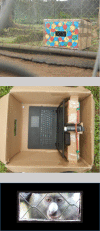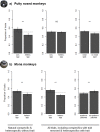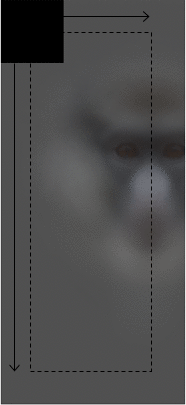The structure of species discrimination signals across a primate radiation
- PMID: 31928629
- PMCID: PMC6957270
- DOI: 10.7554/eLife.47428
The structure of species discrimination signals across a primate radiation
Abstract
Discriminating conspecifics from heterospecifics can help avoid costly interactions between closely related sympatric species. The guenons, a recent primate radiation, exhibit high degrees of sympatry and form multi-species groups. Guenons have species-specific colorful face patterns hypothesized to function in species discrimination. Here, we use a machine learning approach to identify face regions most essential for species classification across fifteen guenon species. We validate these computational results using experiments with live guenons, showing that facial traits critical for accurate classification influence selective attention toward con- and heterospecific faces. Our results suggest variability among guenon species in reliance on single-trait-based versus holistic facial characteristics for species discrimination, with behavioral responses and computational results indicating variation from single-trait to whole-face patterns. Our study supports a role for guenon face patterns in species discrimination, and shows how complex signals can be informative about differences between species across a speciose and highly sympatric radiation.
Keywords: complex signals; evolutionary biology; guenons; species discrimination; visual signal form.
© 2020, Winters et al.
Conflict of interest statement
SW, WA, JH No competing interests declared
Figures

















Similar articles
-
Assessing the potential information content of multicomponent visual signals: a machine learning approach.Proc Biol Sci. 2015 Mar 7;282(1802):20142284. doi: 10.1098/rspb.2014.2284. Proc Biol Sci. 2015. PMID: 25652832 Free PMC article.
-
Character displacement of Cercopithecini primate visual signals.Nat Commun. 2014 Jun 26;5:4266. doi: 10.1038/ncomms5266. Nat Commun. 2014. PMID: 24967517 Free PMC article.
-
Examining deep litter as environmental enrichment for a family group of Wolf's guenons, Cercopithecus wolfi.Zoo Biol. 2010 Sep-Oct;29(5):626-32. doi: 10.1002/zoo.20286. Zoo Biol. 2010. PMID: 19816906
-
Face perception: computational insights from phylogeny.Trends Cogn Sci. 2022 Apr;26(4):350-363. doi: 10.1016/j.tics.2022.01.006. Epub 2022 Feb 26. Trends Cogn Sci. 2022. PMID: 35232662 Review.
-
Occam's razor revisited: guenon species morphology supports evidence for an African influence in Bronze Age Aegean fresco primate iconography from Akrotiri, Thera.Primates. 2021 Sep;62(5):703-707. doi: 10.1007/s10329-021-00930-w. Epub 2021 Jul 7. Primates. 2021. PMID: 34232418 Review.
Cited by
-
The role of between-group signaling in the evolution of primate ornamentation.Evol Lett. 2024 Aug 17;8(6):927-935. doi: 10.1093/evlett/qrae045. eCollection 2024 Dec. Evol Lett. 2024. PMID: 39677580 Free PMC article.
-
Influence of visual background on discrimination of signal-relevant colours in zebra finches (Taeniopygia guttata).Proc Biol Sci. 2022 Jun 8;289(1976):20220756. doi: 10.1098/rspb.2022.0756. Epub 2022 Jun 8. Proc Biol Sci. 2022. PMID: 35673868 Free PMC article.
-
Pelage variation and morphometrics of closely related Callithrix marmoset species and their hybrids.BMC Ecol Evol. 2024 Sep 20;24(1):122. doi: 10.1186/s12862-024-02305-3. BMC Ecol Evol. 2024. PMID: 39304843 Free PMC article.
-
Neural basis of acoustic species recognition in a cryptic species complex.J Exp Biol. 2021 Dec 1;224(23):jeb243405. doi: 10.1242/jeb.243405. Epub 2021 Dec 9. J Exp Biol. 2021. PMID: 34796902 Free PMC article.
-
Simulated evolution of mating signal diversification in a primate radiation.Proc Biol Sci. 2022 Jun 29;289(1977):20220734. doi: 10.1098/rspb.2022.0734. Epub 2022 Jun 22. Proc Biol Sci. 2022. PMID: 35730153 Free PMC article.
References
-
- Andersson M. Sexual Selection. Princeton: Princeton University Press; 1994.
-
- Bates D, Mächler M, Bolker B, Walker S. Fitting linear Mixed-Effects models using lme4. Journal of Statistical Software. 2015;67:1–48. doi: 10.18637/jss.v067.i01. - DOI
-
- Bennett ATD, Cuthill IC, Norris KJ. Sexual selection and the mismeasure of color. The American Naturalist. 1994;144:848–860. doi: 10.1086/285711. - DOI
Publication types
MeSH terms
LinkOut - more resources
Full Text Sources

